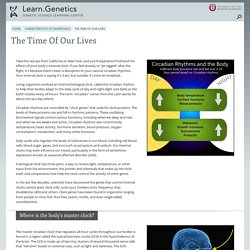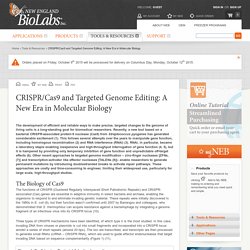

All About The Human Genome Project (HGP) All About The Human Genome Project (HGP) The Human Genome Project (HGP) was one of the great feats of exploration in history - an inward voyage of discovery rather than an outward exploration of the planet or the cosmos; an international research effort to sequence and map all of the genes - together known as the genome - of members of our species, Homo sapiens.

Completed in April 2003, the HGP gave us the ability, for the first time, to read nature's complete genetic blueprint for building a human being. In this section, you will find access to a wealth of information on the history of the HGP, its progress, cast of characters and future. The Time Of Our Lives. Take the red-eye from California to New York, and you'll experience firsthand the effects of your body's internal clock.

If you feel drowsy or "jet lagged" after the flight, it's because there's been a disruption to your natural circadian rhythms. Your internal clock is saying it's 3 am, but outside, it's time for breakfast. Living organisms evolved an internal biological clock, called the circadian rhythm, to help their bodies adapt to the daily cycle of day and night (light and dark) as the Earth rotates every 24 hours. The term "circadian" comes from the Latin words for about (circa) a day (diem). Circadian rhythms are controlled by "clock genes" that code for clock proteins. Daily cycles also regulate the levels of substances in our blood, including red blood cells, blood sugar, gases, and ions such as potassium and sodium.
CRISPR: gene editing is just the beginning. Illustration by Ryan Snook Molecular biologists are riding a wave of new technologies made possible by CRISPR.

Whenever a paper about CRISPR–Cas9 hits the press, the staff at Addgene quickly find out. The non-profit company is where study authors often deposit molecular tools that they used in their work, and where other scientists immediately turn to get them. It is also where other scientists immediately turn to get their hands on these reagents. “We get calls within minutes of a hot paper publishing,” says Joanne Kamens, executive director of the company in Cambridge, Massachusetts.
Heidi Ledford talks Noah Baker through the cutting edge of the CRISPR technique Addgene's phones have been ringing a lot since early 2013, when researchers first reported1, 2, 3 that they had used the CRISPR–Cas9 system to slice the genome in human cells at sites of their choosing. Here, Nature examines five ways in which CRISPR–Cas9 is changing how biologists can tinker with cells.
Broken scissors. CRISPR/Cas9 and Targeted Genome Editing: A New Era in Molecular Biology. The development of efficient and reliable ways to make precise, targeted changes to the genome of living cells is a long-standing goal for biomedical researchers.

Recently, a new tool based on a bacterial CRISPR-associated protein-9 nuclease (Cas9) from Streptococcus pyogenes has generated considerable excitement (1). This follows several attempts over the years to manipulate gene function, including homologous recombination (2) and RNA interference (RNAi) (3). RNAi, in particular, became a laboratory staple enabling inexpensive and high-throughput interrogation of gene function (4, 5), but it is hampered by providing only temporary inhibition of gene function and unpredictable off-target effects (6).
Other recent approaches to targeted genome modification – zinc-finger nucleases [ZFNs, (7)] and transcription-activator like effector nucleases [TALENs (8)]– enable researchers to generate permanent mutations by introducing doublestranded breaks to activate repair pathways. Figure 1.
The lac Operon in E. coli: Introduction. Making SNPs Make Sense. Gene Regulation. Classroom Activities - Natural Selection and Adaptation. EteRNA - Played by Human, Scored by Nature. Homeobox gene family. Homeobox genes are a large family of similar genes that direct the formation of many body structures during early embryonic development.

In humans, the homeobox gene family contains an estimated 235 functional genes and 65 pseudogenes (structurally similar genes that do not provide instructions for making proteins). Homeobox genes are present on every human chromosome, and they often appear in clusters. Many classes and subfamilies of homeobox genes have been described, although these groupings are used inconsistently. Homeobox genes contain a particular DNA sequence that provides instructions for making a string of 60 protein building blocks (amino acids) known as the homeodomain. Most homeodomain-containing proteins act as transcription factors, which means they bind to and control the activity of other genes. Animation : Nature Reviews Genetics.
RNA Splicing. Home DNA Learning Center Preparing students and families to thrive in the gene age Website Search RNA Splicing Description: A step-by-step 2D animation shows how introns are removed during RNA splicing.

Keywords: 2D Animation of Alternative RNA Splicing. Home DNA Learning Center Preparing students and families to thrive in the gene age Website Search 2D Animation of Alternative RNA Splicing Description: A 2D animation shows how the change in the SMN2 gene produces a different protein through RNA splicing.

Keywords: